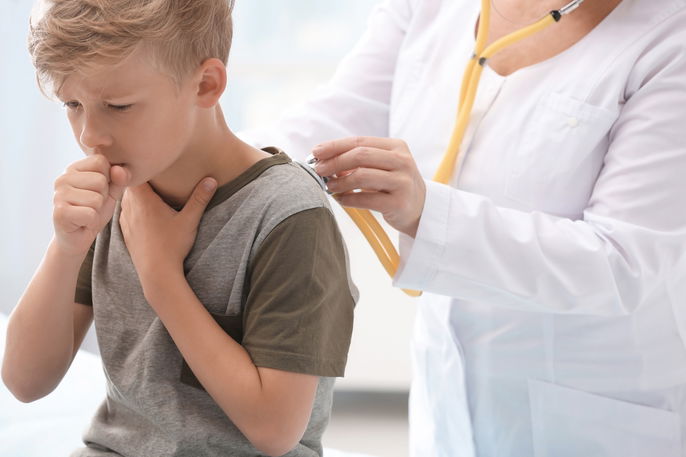What is it:
Adenovirus is a group of viruses that usually causes respiratory infections, like the flu, a cold, croup, bronchitis or pneumonia, however it can also infect the gastrointestinal and nervous systems or the eyes, leading to gastroenteritis, encephalitis or conjunctivitis.
This virus is easily transmitted through direct contact with saliva droplets or respiratory secretions that become suspended in the air when coughing or sneezing. You can also become infected through contact of a contaminated surface or with infected stool (when changing a diaper for example).
Symptoms of adenovirus depends on the affected organ, but can include fever, cough, sore throat, diarrhea or vomiting. You should see your doctor for assessment if you suspect adenovirus, especially if you have a history of a weakened immuned system. Children with suspicion for adenovirus should be assessed, as this virus is associated with juvenile hepatitis.

Common symptoms
The most common symptoms of an adenovirus infection include:
- Fever
- Coughing
- Plugged or runny nose
- Sore throat
- Headache
- Ear ache
- Nausea or vomiting
- Diarrhea
- Stomach ache
- Red or irritated eye
- Tearing eye
When the virus infects the nervous system, you may also experience symptoms like neck and back stiffness, paralysis, muscular weakness, mental confusion or even seizures.
Generally, symptoms of adenovirus are mild and emerge about 2 to 14 days after initial contact with the virus. Nonetheless, children and people with a history of cardiac or respiratory disease or who have a weakened immune system may experience more serious symptoms.
Therefore, you should be assessed by a doctor if you notice any symptoms of adenovirus. The doctor can then confirm a diagnosis and initiate appropriate treatment.
Adenovirus and hepatitis in children
Hepatitis in children has been associated with adenovirus infection. Type 41 adenovirus has been identified in some children with symptoms of acute hepatitis like abdominal pain, diarrhea and vomiting.
Nonetheless, the World Health Organization declares that the exact cause of the hepatitis outbreak in children around the world is still not fully known. More studies are required to understand the causes and other risk factors, like previous infections or exposure to toxins.
How it spreads
Adenovirus is transmitted through direct contact with infected people or through inhalation of saliva droplets or respiratory infections that are suspended in the air from coughing or sneezing.
Transmission can also occur from touching a contaminated surface and then toughing your eyes, nose or mouth.
Adenovirus can also be transmitted through contact with contaminated stool (like when changing a diaper) or through contaminated water (which is less common).
Confirming a diagnosis
Diagnosis of adenovirus is done by the doctor through an evaluation of the presenting symptoms, a physical exam, a health history and lab tests. Lab tests can include blood work to check for antigens, stool testing or a viral swab to test respiratory secretions.
In more serious cases, the doctor can required a PCR test which looks for the presence of adenovirus in respiratory secretions or blood at a molecular level.
Another test the doctor may order when encephalitis is suspected a lumbar puncture, which collects spinal fluid to identify the presence of adenovirus.
Treatment options
Treatment for adenovirus should be guided by a doctor. In most cases, no specific interventions are required as the virus resolves on its own within a few days. Doctors will often recommend an increase in fluid intake to prevent dehydration, rest, and light meals that are easy to digest.
There is no medication available to treat adenovirus, and therefore treatment is aimed at relieving symptoms and preventing complications. The doctor may prescribe:
- Analgesics, like acetaminophen to treat fever and pain
- Saline solution, to perform nasal irrigation and unplug the nose. Learn how to perform a nasal irrigation at home.
- Bronchodilators, to be used in nebulizers or as inhalers to reduce inflammation in the airways and facilitate breathing
- Lubricating eye drops or artificial tears, to relieve eye irritation
In serious cases, admission to the hospital for IV treatment or oxygen may be necessary.
Prevention measures
AdeTo prevent an adenovirus infection, you are advised to:
- Avoid staying in closed spaces with lots of people and poor circulations, like malls and gyms
- Avoid contact with people who may have a cold or flu
- Perform hand hygiene regularly, especially after going to the bathroom or changing a diaper
- Use hand sanitizer frequently throughout the day
- Avoid touching surfaces and then touching your eyes, mouth or nose
- Avoid sharing personal objects that may have come in contact with saliva or respiratory secretions, like cutlery, cups and toothbrushes
- Cover your mouth and nose when sneezing or coughing by using a tissue or the crook of your elbow
In addition, when washing you hands, you should use water and a mild soap. Be sure to scrub for 20 seconds before rinsing and drying, as this can help to prevent adenovirus infection and transmission.






























